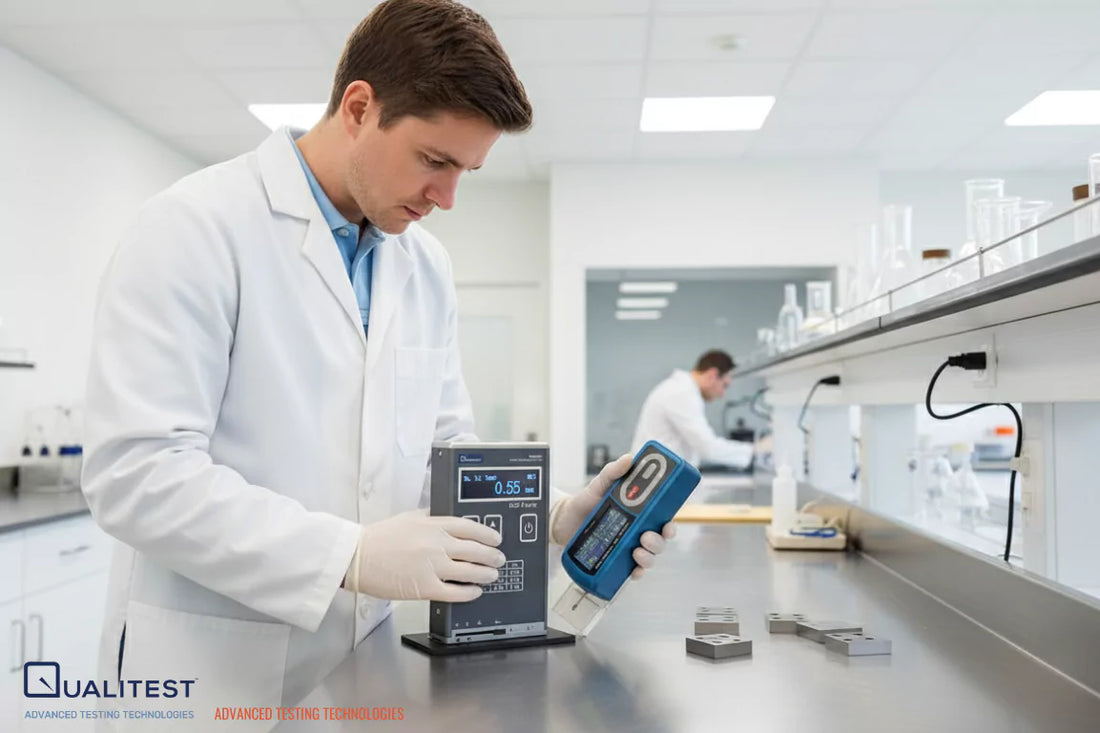Subscribe To Our Newsletter
Get the latest updates on new products and upcoming sales
Available 24/7 at 1.877.884.TEST (8378)

Selecting the correct surface analysis instrument is a critical decision for your product's final quality.
While it's easy to get distracted by impressive-looking new technologies, our position is that the best tool is the one that provides reliable, repeatable data right where it counts: on your production floor.
The ongoing optical vs stylus profilometer discussion is important, and as a long-time supplier, we want to offer a practical perspective to help you choose with confidence.
So, what is the functional difference between these two approaches? It's straightforward.
A stylus profilometer makes physical contact using a fine diamond tip to trace the surface. An optical profilometer, in contrast, is a non-contact method that projects light onto the surface.
Here’s a breakdown of the practical considerations.
We know what some people are thinking: "Won't a diamond tip scratch my part?" It's a fair question, but in almost all cases, the answer is no. The force applied by the stylus is incredibly light and precisely controlled.
For metals, ceramics, and most polymers, this force is negligible and leaves no trace. This concern is really only valid for extremely soft or delicate surfaces, like gels, which are not typical in most manufacturing settings.
Furthermore, let's talk about tricky materials. We've seen optical systems get completely thrown off by surfaces that are highly reflective, transparent, or have multiple layers.
Light-based systems depend on a clean, predictable reflection. If your part is shiny like a mirror or clear like glass, the data can get skewed. A stylus doesn't care about how a surface looks; it feels the physical topography, giving you numbers you can count on.
Another point to consider is the machine's environment.
Optical profilometers are often sensitive creatures. They can be affected by factory vibrations, ambient light, and dust, meaning they usually need a dedicated, clean lab space.
Our stylus-based systems, on the other hand, are built for the production line. They are workhorses designed to function reliably amidst the noise and activity of a real working facility.
Here is our direct comparison of how they perform:
|
Feature |
Stylus Profilometer |
Optical Profilometer |
|
Method |
Physical, contact-based |
Non-contact, light-based |
|
Data Output |
A 2D profile (the essential data you need for QC) |
A 3D surface map (often more data than is practical) |
|
Ideal For... |
Nearly any hard material |
Extremely soft or delicate surfaces |
|
Pace |
Methodical, line-by-line analysis |
Fast, captures large areas at once |
|
Our Focus |
Not the technology we specialize in |
The choice between a stylus vs optical profilometer often comes down to this: do you need a highly accurate, certifiable number for a specific parameter, or do you need a general topographical map? For manufacturing operations, we find the first option is almost always the one that delivers more tangible value.
The specific demands of your industry will heavily influence your choice. From what we have seen, the need for dependable testing on the factory floor is a primary concern. For an operator who needs to perform checks in a busy production environment, a portable and durable instrument isn't a luxury—it's a genuine necessity.
We have spent years working with clients in the automotive and aerospace sectors, where they depend on stylus profilometers to verify the finish on critical components like engine blocks and turbine blades.
But this need extends far beyond that. We see it in heavy machinery for checking the finish on gears and bearings to ensure proper lubrication.
In oil and gas, it's about verifying the integrity of seal faces on valves to prevent leaks. This isn't just about meeting a number on a drawing; it's about preventing costly field failures and ensuring a product's longevity. Getting it right has a direct impact on your operational costs.
This is where a portable instrument like our Portable Surface Roughness Tester - Qualisurf I or the more advanced TR-200 Plus really shows its value. Imagine needing to check a massive gear that can't be moved to a lab. You take the measurement directly to the part, getting an accurate reading right on the shop floor.
Conversely, optical systems are often favored in laboratory settings for medical device or semiconductor analysis. Their home is typically in a research and development lab or a clean-room setting.
They are fantastic for analyzing a single component with extreme detail, but in our view, they aren't built for the speed and volume of routine production checks. We encourage clients to seriously consider if the higher capital cost and environmental sensitivity of an optical system are truly justified for their quality process before they make that investment.
Ultimately, the decision in the optical vs stylus profilometer debate is about getting the right tool for your specific operation. While both technologies have their place, we have built our business on supplying durable, dependable stylus profilometers.
We believe they offer the most practical and cost-effective solution for the vast majority of manufacturing and quality control settings. They are workhorses that deliver the necessary data without extraneous complexity.
We get it because we address these challenges with our customers every day. That's the reason our focus is on a lineup of high-quality, effective stylus-based surface roughness testers. If you are looking for an instrument that is reliable, accurate, and built for a real-world production setting, our group of experts is here to assist.
Contact us today, and we'll help you find the perfect instrument for your application and your budget.
Email have already subscribed!
Get the latest updates on new products and upcoming sales
Thanks for subscribing!
This email has been registered!